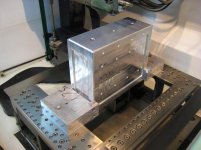Nate Palsa
Plastic
- Joined
- Feb 23, 2016
Hey everyone. This is my first post but I have been referencing this forum for a few years now and have never been disappointed with the help I found.
I have a few quick questions about a troublesome wire EDM cut in aluminum but first, the facts:
Machine - Elox-Fanuc Series M Wire Cut EDM.
Material - 6061 Aluminum, 3x4" and 7.5" cut depth.
We have replaced the resin in our DI system and after cycling the water for an evening, we were able to get the resistivity to 100Kohm*cm (my apologies if any incorrect terminology is used)
As for some of the machine settings;
Voltage - 7
Current - 15
On Time - 5-8 (experimenting)
Off Time - 18-30 (experimenting)
I have read that the voltage and current numbers are not actual values but rather arbitrary assignments to compare with.
I would like to add that after much trial and error with countless wire brakes, the furthest we were able to cut was 1" at an average of 0.005"/minute.
Today, there was a short span of 0.025 - 0.030"/minute of cutting feed with very stable conditions (seldom flashing the low voltage light) and then the wire broke for what seemed like no reason. Now, we are having trouble getting the wire back to the point where it broke. It just seems to feed about 80% there and then low volt/short on in the existing cut kerf until the wire breaks. The wire is being started from the center of a 0.25" diameter drilled hole.
Sorry for the long read but we are really quite stumped with this part and would just like to know if there is anything else that we could try. Please ask any questions about setup or running conditions and I will do my best to answer!
Thanks everyone,
Nate
I have a few quick questions about a troublesome wire EDM cut in aluminum but first, the facts:
Machine - Elox-Fanuc Series M Wire Cut EDM.
Material - 6061 Aluminum, 3x4" and 7.5" cut depth.
We have replaced the resin in our DI system and after cycling the water for an evening, we were able to get the resistivity to 100Kohm*cm (my apologies if any incorrect terminology is used)
As for some of the machine settings;
Voltage - 7
Current - 15
On Time - 5-8 (experimenting)
Off Time - 18-30 (experimenting)
I have read that the voltage and current numbers are not actual values but rather arbitrary assignments to compare with.
I would like to add that after much trial and error with countless wire brakes, the furthest we were able to cut was 1" at an average of 0.005"/minute.
Today, there was a short span of 0.025 - 0.030"/minute of cutting feed with very stable conditions (seldom flashing the low voltage light) and then the wire broke for what seemed like no reason. Now, we are having trouble getting the wire back to the point where it broke. It just seems to feed about 80% there and then low volt/short on in the existing cut kerf until the wire breaks. The wire is being started from the center of a 0.25" diameter drilled hole.
Sorry for the long read but we are really quite stumped with this part and would just like to know if there is anything else that we could try. Please ask any questions about setup or running conditions and I will do my best to answer!
Thanks everyone,
Nate



